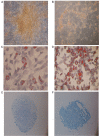Comparative study of biological characteristics of mesenchymal stem cells isolated from mouse bone marrow and peripheral blood
- PMID: 31565222
- PMCID: PMC6760463
- DOI: 10.3892/br.2019.1236
Comparative study of biological characteristics of mesenchymal stem cells isolated from mouse bone marrow and peripheral blood
Abstract
Mesenchymal stromal cells (MSCs) possess self-renewal and multilineage differentiation potential, indicating their prospects as cellular therapeutic agents for regenerative medicine. Although adult bone marrow (BM) is the major source of these cells for clinical use, harvesting requires invasive procedures. Therefore, alternative sources, such as peripheral blood (PB), are needed. The objective of the current study was to compare PB-MSCs and BM-MSCs with regard to their biological characteristics. PB-MSCs and BM-MSCs were isolated from 4-week-old BALB/c white mice by density gradient centrifugation and cultured in DMEM + 10% fetal bovine serum until passage four. Morphological features, proliferation, cell surface marker expression and trilineage differentiation potential were assessed for both PB-MSCs and BM-MSCs. No significant differences in morphological features were observed. BM-MSCs had a higher proliferative capability than PB-MSCs as measured by XTT assays. Both PB-MSCs and BM-MSCs had broadly similar cell surface marker expression, but PB-MSCs had positive expression of cluster of differentiation (CD)146 and CD140b. Both PB-MSCs and BM-MSCs were capable of trilineage differentiation. Although BM-MSCs had a greater capacity for osteogenic and chondrogenic differentiation than PB-MSCs, PB-MSCs had a better capability for adipogenic differentiation than BM-MSCs. In conclusion, PB-MSCs and BM-MSCs have very similar biological characteristics. Thus, PB is a promising source for easily obtaining MSCs in mice.
Keywords: BALB/c mice; bone marrow; bone marrow-mesenchymal stromal cells; mesenchymal stem cells; peripheral blood; peripheral blood-mesenchymal stromal cells.
Copyright © 2019, Spandidos Publications.
Figures




